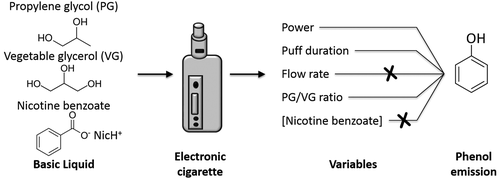当前位置:
X-MOL 学术
›
Chem. Res. Toxicol.
›
论文详情
Our official English website, www.x-mol.net, welcomes your feedback! (Note: you will need to create a separate account there.)
Vaped Humectants in E-Cigarettes Are a Source of Phenols.
Chemical Research in Toxicology ( IF 4.1 ) Pub Date : 2020-07-28 , DOI: 10.1021/acs.chemrestox.0c00132 Rachel El-Hage 1, 2 , Ahmad El-Hellani 1, 2 , Rola Salman 2, 3 , Soha Talih 2, 3 , Alan Shihadeh 2, 3 , Najat Aoun Saliba 1, 2
Chemical Research in Toxicology ( IF 4.1 ) Pub Date : 2020-07-28 , DOI: 10.1021/acs.chemrestox.0c00132 Rachel El-Hage 1, 2 , Ahmad El-Hellani 1, 2 , Rola Salman 2, 3 , Soha Talih 2, 3 , Alan Shihadeh 2, 3 , Najat Aoun Saliba 1, 2
Affiliation

|
Electronic cigarettes (ECIGs) have always been promoted as safer alternatives to combustible cigarettes. However, a growing amount of literature shows that while ECIGs do not involve combustion-derived toxicants, thermal degradation of the main constituents of ECIG liquid produces toxicants such as carbonyls. In this study, we report the detection of phenolic compounds in ECIG aerosols using a novel analytical method. The introduced method relies on liquid–liquid extraction to separate phenols from the major constituents of ECIG aerosol: propylene glycol (PG) and vegetable glycerol (VG). Phenol emissions from ECIGs were tested at different powers, puff durations, PG/VG ratios, nicotine benzoate concentrations, and flow rates to assess the influence of these operating parameters on phenol formation. The performance metrics showed that the analytical method has high specificity and reliability to separate and quantify phenolic compounds in ECIG aerosols. Increasing power and puff duration significantly increased all phenol emissions, while flow rate had no significant effects. The phenol profile in the ECIG aerosol was dominated by the unsubstituted phenol that reached comparable levels to those of IQOS, combustible cigarettes, and waterpipe. In contrast, low levels of the more toxic phenolic compounds, like catechol and hydroxyquinone, were quantified in ECIG aerosols. Emission of toxicants is presented, for the first time in this study, as the yield per unit of time, or flux (μg/s), which is more suitable for interstudy and interproduct comparison. This work demonstrates a robust analytical method for isolating and quantifying phenol emissions in ECIG aerosols. Using this method, the study shows that phenols, which are not present in the simple solution of nicotine benzoate dissolved in mixtures of PG/VG, are formed upon vaping. Phenol emissions are independent of the nicotine benzoate concentration but significantly correlated with the PG/VG ratio. Emissions increased with power and puff duration, consistent with conditions that lead to a higher temperature and greater thermal degradation.
中文翻译:

电子烟中的吸湿剂是酚类的来源。
电子香烟 (ECIG) 一直被宣传为可燃香烟的更安全替代品。然而,越来越多的文献表明,虽然 ECIG 不涉及燃烧衍生的毒物,但 ECIG 液体主要成分的热降解会产生毒物,例如羰基化合物。在这项研究中,我们报告了使用一种新的分析方法检测 ECIG 气溶胶中的酚类化合物。引入的方法依赖于液-液萃取从 ECIG 气溶胶的主要成分:丙二醇 (PG) 和植物甘油 (VG) 中分离酚类。在不同的功率、抽吸持续时间、PG/VG 比率、苯甲酸尼古丁浓度和流速下测试了 ECIG 的苯酚排放,以评估这些操作参数对苯酚形成的影响。性能指标表明,该分析方法在分离和量化 ECIG 气溶胶中的酚类化合物方面具有很高的特异性和可靠性。增加功率和抽吸持续时间显着增加了所有苯酚的排放,而流速没有显着影响。ECIG 气溶胶中的苯酚成分以未取代苯酚为主,达到与 IQOS、可燃香烟和水烟相当的水平。相比之下,在 ECIG 气溶胶中量化了低水平的毒性更强的酚类化合物,如儿茶酚和羟基醌。在本研究中,有毒物质的排放首次以单位时间的产量或通量 (μg/s) 的形式呈现,这更适合于研究间和产品间的比较。这项工作展示了一种可靠的分析方法,用于分离和量化 ECIG 气溶胶中的苯酚排放。使用这种方法,研究表明,苯甲酸尼古丁溶解在 PG/VG 混合物中的简单溶液中不存在酚类物质,这些酚类物质是在吸电子烟时形成的。苯酚排放与苯甲酸尼古丁浓度无关,但与 PG/VG 比率显着相关。排放随着功率和抽吸持续时间而增加,这与导致更高温度和更大热降解的条件一致。苯酚排放与苯甲酸尼古丁浓度无关,但与 PG/VG 比率显着相关。排放随着功率和抽吸持续时间而增加,这与导致更高温度和更大热降解的条件一致。苯酚排放与苯甲酸尼古丁浓度无关,但与 PG/VG 比率显着相关。排放随着功率和抽吸持续时间而增加,这与导致更高温度和更大热降解的条件一致。
更新日期:2020-09-21
中文翻译:

电子烟中的吸湿剂是酚类的来源。
电子香烟 (ECIG) 一直被宣传为可燃香烟的更安全替代品。然而,越来越多的文献表明,虽然 ECIG 不涉及燃烧衍生的毒物,但 ECIG 液体主要成分的热降解会产生毒物,例如羰基化合物。在这项研究中,我们报告了使用一种新的分析方法检测 ECIG 气溶胶中的酚类化合物。引入的方法依赖于液-液萃取从 ECIG 气溶胶的主要成分:丙二醇 (PG) 和植物甘油 (VG) 中分离酚类。在不同的功率、抽吸持续时间、PG/VG 比率、苯甲酸尼古丁浓度和流速下测试了 ECIG 的苯酚排放,以评估这些操作参数对苯酚形成的影响。性能指标表明,该分析方法在分离和量化 ECIG 气溶胶中的酚类化合物方面具有很高的特异性和可靠性。增加功率和抽吸持续时间显着增加了所有苯酚的排放,而流速没有显着影响。ECIG 气溶胶中的苯酚成分以未取代苯酚为主,达到与 IQOS、可燃香烟和水烟相当的水平。相比之下,在 ECIG 气溶胶中量化了低水平的毒性更强的酚类化合物,如儿茶酚和羟基醌。在本研究中,有毒物质的排放首次以单位时间的产量或通量 (μg/s) 的形式呈现,这更适合于研究间和产品间的比较。这项工作展示了一种可靠的分析方法,用于分离和量化 ECIG 气溶胶中的苯酚排放。使用这种方法,研究表明,苯甲酸尼古丁溶解在 PG/VG 混合物中的简单溶液中不存在酚类物质,这些酚类物质是在吸电子烟时形成的。苯酚排放与苯甲酸尼古丁浓度无关,但与 PG/VG 比率显着相关。排放随着功率和抽吸持续时间而增加,这与导致更高温度和更大热降解的条件一致。苯酚排放与苯甲酸尼古丁浓度无关,但与 PG/VG 比率显着相关。排放随着功率和抽吸持续时间而增加,这与导致更高温度和更大热降解的条件一致。苯酚排放与苯甲酸尼古丁浓度无关,但与 PG/VG 比率显着相关。排放随着功率和抽吸持续时间而增加,这与导致更高温度和更大热降解的条件一致。


























 京公网安备 11010802027423号
京公网安备 11010802027423号